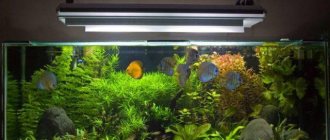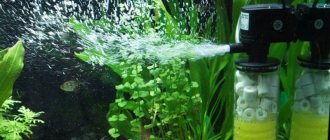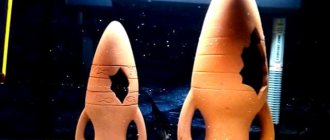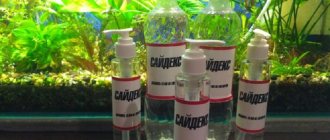The need for lighting equipment in an aquarium
The choice of optimal lighting is extremely important for the normal development of fish, shellfish, bacteria and, of course, plants, since their life processes are directly related to photosynthesis and, therefore, require normal lighting.
The supply of natural light to the aquarium is often limited:
- location of the tank;
- the duration of daylight hours depending on the time of year.
Direct sunlight can provoke intense algae growth and cause so-called “blooming” of water, which can also destroy the ecosystem.
Artificial lighting of such a reservoir helps to extend daylight hours by several hours, which makes it possible to bring the living conditions of the tropical inhabitants of the aquarium closer to their natural environment and alternate the cycle of day and night in a more familiar mode for them.
Modern technical means make it possible to organize the so-called stepwise method of aquarium lighting - the use of timer sockets that can help
regulation of water illumination during the day, that is:
- gradual decrease in light intensity;
- turning it off;
- inclusion;
- gradual increase in light radiation;
- maximum intensity of light rays for several hours.
The use of timers that simply plug into an electrical outlet makes it possible to automate the lighting in the aquarium.
Selection of LEDs
To choose the right LED strip lighting, you need to pay attention to the following parameters:
- aquarium size;
- species of fish and plants living in the reservoir;
- degree of moisture protection and moisture insulation (IP) of the tape;
- power and brightness of LEDs;
- LED strip length;
- duration of backlight operation.
In most cases, LED lighting is mounted in the lid of the aquarium, but to decorate a home pond, you can place it on the bottom and walls around the perimeter. Only IP68 waterproof tape is installed under water. Do not forget that long-term illumination from the depths of the tank can negatively affect the behavior of fish and plant growth.
If only fish live in the aquarium, then you can use the simplest LED strip with a white light spectrum. But you shouldn’t go too far: if there is too much light, the inhabitants of the aquarium may begin to get sick, and the water will acquire an unpleasant odor and become cloudy.
For a pond with plants, you should be more careful in choosing the light spectrum, the power of the lamps and their placement in the tank. In addition, algae require red-orange and violet-blue lighting, preferably combined with each other.
Optimal aquarium lighting - balanced ecosystem
Various devices are used as light sources for aquariums:
- conventional incandescent lamps and their energy-saving analogues;
- fluorescent lamps;
- LEDs.
However, the illumination of the aquarium depends not only on the light source and its power, but is also adjusted:
- water composition;
- properties of the materials from which the tank is made;
- height of the aquarium walls.
Therefore, it is necessary to create conditions under which the light flux would penetrate the entire thickness of the water, allowing not only the upper leaves of plants, but also the stems to develop well.
In a balanced, closed ecosystem, the process of photosynthesis can be observed firsthand, as small bubbles of oxygen produced by plants regularly break off the leaves and rush to the surface of the water. In addition, the state of the aquatic flora allows us to judge the lack or excess of illumination:
- Excessive light causes green algae to multiply;
- poor lighting causes plants to change color and destabilize their ability to produce oxygen.
Consequently, optimal conditions for life in a closed ecosystem can be provided by uniform, diffused light of the required intensity and a certain spectrum.
Advantages of diode devices
Diode lamps have been used for aquarium lighting since recent times, but have already managed to displace many analogues from their leading positions. This is not surprising, because diodes have a large number of undeniable advantages.
- Economical. In addition to the fact that the cost of devices is significantly lower than competitive products, LEDs are able to reproduce beams with increased brightness with minimal electricity consumption.
- High strength. Regardless of the type of diodes, they have an increased degree of strength and therefore are not susceptible to mechanical stress. Due to the absence of a spiral, they do not respond to vibrations.
- Operational life. The design can serve properly for more than 5 years, which is several times higher than its analogues.
- Choice. Thanks to the spectral range, you can choose the most optimal option for both fish and plants.
Backlight color may vary
- Safety. Since the lamps operate on low voltage, with open contacts they are not capable of causing much harm to the user. They can also be classified as fireproof light sources, since they have a protective layer against moisture.
- Temperature. Even with continuous operation for 7-10 hours, the elements do not emit excess heat. Thus, the desired temperature is always maintained in the container.
VIDEO: DIY waterproof aquarium lighting
Calculation of proper aquarium lighting
Regular monitoring of the condition of the aquarium allows you to notice the lack or excess of illumination and change its intensity. The intensity of illumination and the power of the equipment necessary for these purposes are conventionally calculated based on several parameters:
- a light source power of 0.1–0.3 Watt per liter of water is required for tanks without vegetation;
- Illumination of 0.2–0.4 Watt per liter is used for ecosystems with shade-loving fish species and representatives of aquatic flora, for example, plants that do not require an abundance of light: Java moss, Echinodorus, Cryptocoryne;
- lamps with a power of 0.4–0.5 Watt are used in aquariums where intensive plant growth is not provided, or their number is intentionally limited;
- sources of 0.5–0.8 watts per liter create optimal illumination for the life of most aquarium fish and light-demanding plants;
- Illumination of 0.8–1 Watt per liter is created for natural aquariums, the lighting of which involves dense placement of plant life forms.
However, this factor is influenced by the depth of the tank, so arranging an aquarium with high walls may require light sources with higher power.
The choice of the source itself is now not limited to tungsten lamps, and experienced aquarists can have their own preferences, using:
- luminescent;
- halogen;
- LED devices.
They not only help create optimal living conditions for the ecosystem, but also help turn the aquarium into an original element of room design.
In addition, the industry produces special phytolamps and underwater lamps of various operating principles that can be immersed directly in water. However, devices that are mounted on the top lid of the container or installed above glass or plastic covering the surface of the water are more often used. Considering that the intensity of illumination drops by approximately half with every ten centimeters of water deep into the aquarium, it is necessary to accurately calculate the illumination of the aquarium and select equipment with appropriate characteristics.
Intensity calculation
There are various methods for calculating light intensity for aquariums. The main ones:
- selection by volume;
- selection by depth.
Selection by volume
Selecting lighting according to the volume of the aquarium is quite simple. We must assume that 1 liter of water requires 0.5 W of power. And then, using simple mathematical operations, you can calculate the required power of lighting devices for your aquarium and no calculator is needed.
| Aquarium volume, l | Lamp power, W | Number of lamps |
| 25 | 8 | 1 |
| 50 | 15 | 1 |
| 60 | 15 | 1 |
| 130 | 18 | 2 |
| 220 | 30 | 4 |
| 310 | 38 | 4 |
| 350 | 36 | 4 |
| 400 | 36 | 4 |
| 500 | 58 | 4 |
Streams of light as they pass through the water lose their strength; accordingly, at the depth of the aquarium, the illumination is much less than in its upper layers. To calculate by depth, it is necessary to divide the height of the water column by every 10 cm. For every 10 cm, the illumination is halved. We need to know what kind of bottom illumination we want to get in the end. And based on this, calculate the required power.
Selection by depth:
Ep = Unit / (Ko * Kv), where Unit is the illumination on the lower surface of the aquarium, Lx; Ko – light attenuation coefficient (depending on the height of the aquarium); Kv – coefficient of light attenuation due to water. Equal to 0.83.
Light attenuation coefficient depending on depth:
- 0.3 m – 0.47-0.65;
- 0.4 m – 0.37-0.55;
- 0.5 m – 0.29-0.48;
- 0.6 m – 0.22-0.40;
- 0.7 m – 0.17-0.35;
- 0.8 m – 0.14-0.30.
Result of improper lighting
If the calculation and selection of lighting for the aquarium is incorrect, the results can be disappointing. If there is insufficient lighting, the growth rate of plants will slow down or stop altogether, and light-loving plants may even die.
A yellow coating may appear on the walls of the aquarium, this is a sign of diatoms. If there is too much light, aquarium plants may fold their leaves and an outbreak of green algae may occur. This all significantly worsens the appearance of the aquarium. It is sometimes very difficult to get rid of such consequences as algae! Therefore, it is very important to initially choose the right lighting and fertilizers.
Emission spectrum and light sources
One of the most important parameters influencing the metabolic processes of aquatic plants is the spectrum of light flux, which should also be taken into account when organizing light in a closed ecosystem. Since during daylight hours water transforms different light rays, which are capable of taking on different shades, the optimal spectrum temperature is considered to be 5000 K, which corresponds to light green shades of the spectrum. Therefore, when choosing equipment for proper lighting of an aquarium, experts recommend using light sources with the required power, with a wide spectrum and a color temperature of 5600–10,000 K.
Incandescent lamps
Despite the low efficiency, the release of a large amount of heat with minimal efficiency, and a short operating period, conventional incandescent lamps have such an emission spectrum. It almost completely coincides with the solar one, that is, the one that is necessary for plants and other aquatic inhabitants.
Fluorescent lamps
Fluorescent lamps are often chosen by aquarists for several reasons:
- due to the dimensions of the glow area;
- variety of model range;
- absence of thermal radiation;
- sufficiently long service life.
However, in general, these devices do not have a radiation spectrum sufficient for normal lighting of aquariums. However, the industry produces specialized lamps of a similar operating principle that are capable of providing good illumination in aquariums of certain sizes.
Metal halide lamps
Metal halide lamps, which are often used to organize effective lighting in an aquarium, have improved characteristics:
- high power and large range;
- light output exceeding that of many modern light sources;
- long service life;
- the ability to create a light regime that practically coincides with natural light in natural bodies of water, that is, light that needs to be maintained for a certain period for aquarium plants and other aquatic life forms.
In addition, metal halide elements help to equip a Dutch or marine aquarium with good light and create contrasting lighting that will help the artificial ecosystem become a bright accent of the interior.
However, the thermal radiation of such a lamp dictates special conditions for the placement of the panel or spotlight, namely: a special suspended structure, which requires more careful calculation for aquariums that are planned to be illuminated with these devices, since placing such light sources close to the surface of the water can be harmful to plants .
LED lamps
The complex production technology of metal halide lamps does not allow making such a light source yourself, unlike equipment equipped with LEDs, which many aquarists design and assemble with their own hands.
In addition, preference is given to LED lamps for a number of reasons:
- economical energy consumption;
- operation from low voltage in the network;
- long period of operation.
LED bulbs
The simplest option for creating LED lighting in an aquarium is LED lamps. This is primarily suitable for small aquariums up to 50 l. Their covers often already contain sockets intended for conventional classic incandescent lamps with E27 and E14 sockets. For such options, all that remains is to select and purchase a light bulb of the required power and light temperature.
More expensive options will be ready-made rectangular-shaped LED panels of a certain length for ready-made aquariums of standard sizes. This LED aquarium light will be very easy to install. For example, you can look at equipment from the well-known company Aqualighter.
Calculation of lighting in an aquarium in lumens
In principle, calculating lighting in an aquarium with LED elements is practically no different from determining illumination using other sources of light radiation, however, when equipping aquariums of 100 liters or more with lamps, experts recommend calculating lighting parameters in lux.
Lux is a unit of illumination of an area of 1 meter with a luminous flux of 1 lumen, which allows, knowing the area of the bottom, to calculate the required number of point light sources.
For example, for most aquariums that have a height greater than the length with ordinary plants, 6,000–10,000 lux are needed, but if the plants are light-loving, then calculating the lighting in the aquarium will allow this parameter to be increased to 10,000–15,000 lux. By multiplying the bottom area of the aquarium in meters by the desired illumination value in lux, you can calculate the parameters of the desired source in lumens, which are compared with the values indicated by manufacturers on all LED lamps or strips.
The required meter of LED strip, with a certain color spectrum of radiation, and a power supply of the required power are purchased in retail chains, and a reliable, durable lamp is assembled, the design of which allows it to be used for any aquarium.
Tips for choosing lamps
We looked at how many lumens and watts per liter you need for an aquarium. It remains to give some advice on choosing a lamp:
- if the aquarium is wide, more than 40 cm, it is better to install not one, but two diode devices, which will contribute to a more uniform distribution of the light flux;
- installing a dimmer will allow you to control the lighting intensity;
- for large and tall containers it is better to use metal halide backlighting;
- When installing any type of equipment, you need to take into account heat transfer and, if necessary, install a fan.
It is necessary to take into account heat transfer and, if necessary, install a fan
The amount of light that penetrates can be hampered by the presence of a cover glass, the age of the lamp, and even the air temperature. Transparent, clean water allows light to pass through well, but if it is too intense, algae will fill the container.
It will not be possible to calculate the correct lighting intensity and the number of devices right away. In this matter, you cannot do without trial and error. However, green pets will indicate problems with their appearance. Perhaps the aquarium will begin to become overgrown with algae or the plants will begin to wither, turn yellow and look lifeless. Then you will have to adjust the calculations and purchase additional lighting, taking into account the fact that excess light will also not bring health to the plants.
How is the lighting organized in your aquarium? What kind of lamps do you use? How were the calculations carried out? Share your experience in the comments.
Underwater lighting capabilities
Additional lighting for the aquarium, if necessary, is created by underwater lighting. Such lamps are attached to the walls using special suction cups and decorated with aquatic vegetation or stones.
An underwater lamp is a light source of different operating principles, placed in a sealed flask, which helps prevent danger to aquarium fish and other representatives of flora and fauna living in an artificial ecosystem.
The industry produces devices that emit light in the following spectrum tones:
- white;
- red;
- blue;
- green.
They help improve the illumination of the aquarium and enhance its decorative functions in the interior of the room.
Thanks to the use of LEDs and having certain knowledge in electrical engineering, many aquarists equip such devices themselves.
The organization of proper diffuse lighting of the aquarium is of great importance for the normal functioning of a closed ecosystem, affecting the metabolic processes of plants, photosynthesis and, consequently, the saturation of the aquatic environment with oxygen necessary for the life of living organisms.
In addition, skillfully created lighting and illumination allows you to turn an ordinary glass container into an original element of room design, attract the eyes of visitors and watch with interest the life of the inhabitants behind the glass, both in a small and large marine aquarium.
The best phytolamps for growing aquarium plants
Models from this category create the best conditions for photosynthesis and growth of aquarium plants. The lamps do not heat the water, do not burn the leaves and do not harm the fauna living nearby.
Dennerle Trocal Special Plant
5.0★★★★★editorial assessment
98% of buyers recommend this product
Dennerle lamps are manufactured using the new Longlife-Technik automated technology, which provides them with more than 10,000 hours of operation. The UV-stop coating film prevents the formation of algae directly on the lamp.
The spectrum gives a glow close to that of the sun and promotes rapid growth of plants (even very fastidious ones). High color rendering ensures that the fish are illuminated in the most advantageous shades.
Pros:
- Suitable for all aquarium lights;
- Very long working life;
- The UV-stop film also protects against flying fragments when dropped;
- Economical.
Minuses:
- Expensive.
To create a unique planted aquarium with proper vegetation, equip your pond with such a lamp. It will also help control algae growth.
Osram T8 Fluora
4.8★★★★★editorial assessment
89% of customers recommend this product
The fluorescent model has proven itself well not only among aquarists, but also among those who like to grow indoor plants. Still, such a lamp is more appropriate for home ponds: its glow, with an emphasis on the red and blue spectral regions, activates the growth of flora and interestingly highlights aquatic inhabitants.
Pros:
- Does not heat water during operation;
- Many variations in power and size;
- Consumes energy economically;
- Affordable price.
Minuses:
- Over time, it loses its “special” properties.
If the plants in your herbalist have become dull and have stopped growing, pamper them with the glow of an Osram Fluora lamp - they will definitely thank you with lush growth.
Sylvania FHO T5 Aquastar
4.7★★★★★editorial assessment
85% of customers recommend this product
The spectrum of a fluorescent lamp from a German brand with a high proportion of blue and red radiation is as close as possible to tropical sunlight. This model can be used for both freshwater and marine aquariums. It stimulates the lush growth of plants and corals, highlighting the natural color of fish.
Pros:
- Excellent light output;
- Provides excellent flora growth and protection from algae;
- Lots of power options.
Minuses:
- Light output decreases after 12 months of use due to natural aging.
With such lighting, a tropical aquarium will sparkle with new colors. And the glow of the lamp will not harm either flora or fauna.










